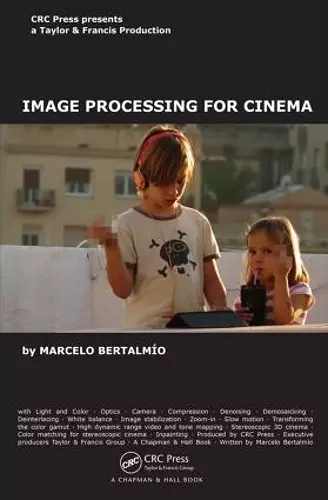Image Processing for Cinema
Format:Hardback
Publisher:Taylor & Francis Inc
Published:4th Feb '14
Currently unavailable, and unfortunately no date known when it will be back
This hardback is available in another edition too:
- Paperback£65.99(9780367378936)

Image Processing for Cinema presents a detailed overview of image processing techniques that are used in practice in digital cinema. The book shows how image processing has become ubiquitous in movie-making, from shooting to exhibition. It covers all the ways in which image processing algorithms are used to enhance, restore, adapt, and convert moving images. These techniques and algorithms make the images look as good as possible while exploiting the capabilities of cameras, projectors, and displays.
The author focuses on the ideas behind the methods, rather than proofs and derivations. The first part of the text presents fundamentals on optics and color. The second part explains how cameras work and details all the image processing algorithms that are applied in-camera. With an emphasis on state-of-the-art methods that are actually used in practice, the last part describes image processing algorithms that are applied offline to solve a variety of problems.
The book is designed for advanced undergraduate and graduate students in applied mathematics, image processing, computer science, and related fields. It is also suitable for academic researchers and professionals in the movie industry.
"... it is a great relief to find Image Processing for Cinema by Marcelo Bertalmio. He wrote it as a textbook for graduate students in areas, including applied mathematics, image processing, and computer science, as a comprehensive guide to digital cinema for industry professionals. ... Bertalmio's explanations are in a league with Walter (The Technique of the Film Cutting Room)-written in a way that doesn't cause the eyes to glaze over. It is technical writing that we can read. It takes the reader into a subject but gives him or her exit points at various levels of curiosity satisfaction. ... this book is a resource of in-depth information on digital image technology." -Jay Cassidy, A.C.E., CINEMAEDITOR, Vol. 64, 2014 "As the evolution of motion picture production and post-production has progressed from the photochemical era to the digital era, two trends have emerged: the process is more 'accessible' and 'democratic' yet the gap between the artist and the technology has widened. Now comes Marcelo Bertalmio's textbook, Image Processing for the Cinema. With his remarkable ability to take the reader from the basic idea to the mathematics beneath without losing the non-mathematician along the way, Bertalmio's explanations never intimidate but provide clarity at whatever level of depth desired. This book is a solid source for anyone who is concerned with digital image sequences-those actively engaged in motion picture production, post-production, visual effects, distribution, as well as students, academics, and those who design and manufacture the digital devices of the future." -Jay Cassidy, 2014, 2013, and 2008 Academy Award nominee for best achievement in film editing "This is a comprehensive, informative, and well written book, which covers all aspects of the production and processing of cinema. (Cinema means digital cinema here.) I have not seen any other text that serves this purpose. It does not deal with visual effects or computer generated images, but with the ways algorithms are used to make images look as good as possible. The author attempts the Herculean task of going from light and color through optics to how cameras work and the image processing algorithms used in-camera. Finally, offline image processing algorithms are discussed. The goal is to bridge the communication gap between movie professionals and image processing researchers. There are enough equations to satisfy most researchers but the material remains accessible to nonexperts. There is a lot of material on open questions (like how humans really perceive color), which could provoke new research. I recommend this book strongly. It is suitable for people from the movie industry to researchers as well as undergraduate and graduate students interested in imaging and cinema." -Stanley Osher, Professor of Mathematics, Computer Science, and Electrical Engineering, University of California, Los Angeles "As a developer and implementer of moving-image processing algorithms for end-user software, I think this book is a unique contribution in terms of providing sufficiently relevant and advanced technical information about contemporary video imagery issues. And it does so without overwhelming the reader with mathematical proofs (pages of mathematical notations) and less important details. As briefly noted in the book, many academic contributions are very hard to apply generally in practice as they often fail to consider the necessary shortcuts of technology implementation. The book thus strikes a hard balance in terms of readability between mathematical over-formulation and over-simplification. The most important topics are properly contextualized (and with references using the language of the technology in the field rather than using pure physics/math descriptions). Then some algorithmic solutions are presented, making it also a very useful reference for a software developer who typically has a general understanding but needs some initial guidance to address a particular problem he or she might not be familiar with." -Pierre Jasmin, RE:Vision Effects, www.revisionfx.com, and 2006 Academy Award winner for technical achievements
ISBN: 9781439899274
Dimensions: unknown
Weight: 680g
322 pages